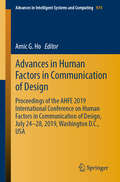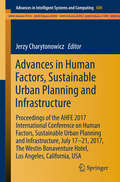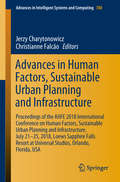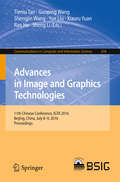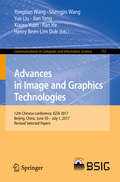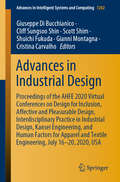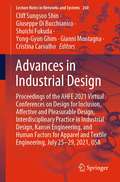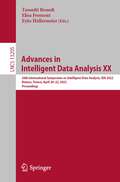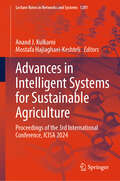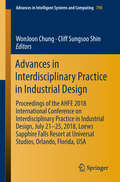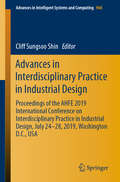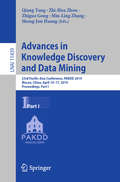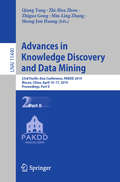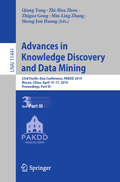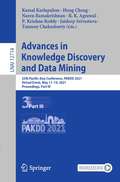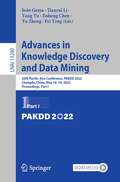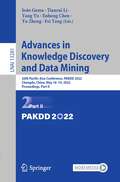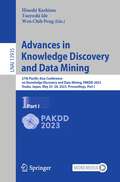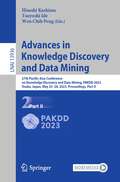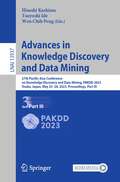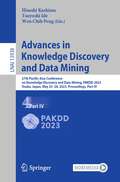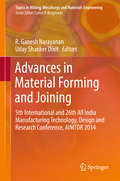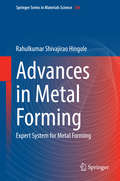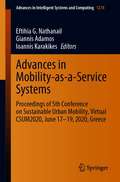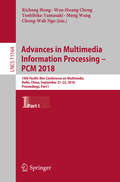- Table View
- List View
Advances in Human Factors in Communication of Design: Proceedings of the AHFE 2019 International Conference on Human Factors in Communication of Design, July 24-28, 2019, Washington D.C., USA (Advances in Intelligent Systems and Computing #974)
by Amic G. HoThis book focuses on the emerging role of human factors in understanding, communicating with and engaging users. It reports on innovative approaches, highlighting visuals cues, such as new typographies, geometries and graphics for mobile and computer interfaces. The book also covers image and video processing, user-focused data compression, generative visuals, computational photography, and interactive design. Further topics include creative and empathetic design, human touch in digital graphics and experiential graphics. Based on the AHFE 2019 International Conference on Human Factors in Communication of Design, held on July 24-28, 2019, in Washington D.C., USA, this book reports on new findings, best-practices and case studies, providing readers with a fresh perspective and novel insights into the applications of human factors for enhancing the communication of design to users.
Advances in Human Factors, Sustainable Urban Planning and Infrastructure: Proceedings of the AHFE 2017 International Conference on Human Factors, Sustainable Urban Planning and Infrastructure, July 17−21, 2017, The Westin Bonaventure Hotel, Los Angeles, California, USA (Advances in Intelligent Systems and Computing #600)
by Jerzy CharytonowiczThis book deals with human factors research directed towards realizing and assessing sustainability in the built environment. It reports on advanced engineering methods for sustainable infrastructure design, as well as on assessments of the efficient methods and the social, environmental, and economic impact of various designs and projects. The book covers a range of topics, including the use of recycled materials in architecture, ergonomics in buildings and public design, sustainable design for smart cities, design for the aging population, industrial design, human scale in architecture, and many more. Based on the AHFE 2017 International Conference on Human Factors, Sustainable Urban Planning and Infrastructure, held on July 17-21, 2017, in Los Angeles, California, USA, this book, by showing different perspectives on sustainability and ergonomics, represents a useful source of information for designers in general, urban engineers, architects, infrastructure professionals, practitioners, public infrastructure owners, policy makers, government engineers and planners, as well as operations managers, and academics active in applied research.
Advances in Human Factors, Sustainable Urban Planning and Infrastructure: Proceedings of the AHFE 2018 International Conference on Human Factors, Sustainable Urban Planning and Infrastructure, July 21-25, 2018, Loews Sapphire Falls Resort at Universal Studios, Orlando, Florida, USA (Advances in Intelligent Systems and Computing #788)
by Jerzy Charytonowicz Christianne FalcãoThis book discusses human factors research directed towards realizing and assessing sustainability in the built environment. It reports on advanced engineering methods for sustainable infrastructure design, as well as on assessments of the efficient methods and the social, environmental, and economic impact of various designs and projects. The book covers a range of topics, including the use of recycled materials in architecture, ergonomics in buildings and public design, sustainable design for smart cities, design for the aging population, industrial design, human scale in architecture, and many more. Based on the AHFE 2018 International Conference on Human Factors, Sustainable Urban Planning and Infrastructure, held on July 21–25, 2018, in Orlando, Florida, USA, it offers various perspectives on sustainability and ergonomics. As such, it is a valuable reference resource for designers, urban engineers, architects, infrastructure professionals, public infrastructure owners, policy makers, government engineers and planners, as well as operations managers and academics active in urban and infrastructure research.
Advances in Image and Graphics Technologies: 11th Chinese Conference, IGTA 2016, Beijing, China, July 8-9, 2016, Proceedings (Communications in Computer and Information Science #634)
by Sheng Li Ran He Tieniu Tan Guoping Wang Shengjin Wang Yue Liu Xiaoru YuanThis book constitutes the refereed proceedings of the Chinese Conference on Image and Graphics Technologies and Applications, IGTA 2013, held in Beijing, China, in April 2013. The 40 papers and posters presented were carefully reviewed and selected from 89 submissions. The papers address issues such as the generation of new ideas, new approaches, new techniques, new applications and new evaluation in the field of image processing and graphics.
Advances in Image and Graphics Technologies: 12th Chinese conference, IGTA 2017, Beijing, China, June 30 – July 1, 2017, Revised Selected Papers (Communications in Computer and Information Science #757)
by Ran He Shengjin Wang Yue Liu Xiaoru Yuan Jian Yang Yongtian Wang Henry Been-Lirn DuhThis book constitutes the referred proceedings of the 8th China Conference on Image and Graphics Technologies and Applications, IGTA 2014, held in Beijing, China, in June 2014. The 39 papers presented were carefully reviewed and selected from 110 submissions. They cover various aspects of research in image processing and graphics and related topics, including object detection, pattern recognition, object tracking, classification, image segmentation, reconstruction, etc.
Advances in Industrial Design: Proceedings of the AHFE 2020 Virtual Conferences on Design for Inclusion, Affective and Pleasurable Design, Interdisciplinary Practice in Industrial Design, Kansei Engineering, and Human Factors for Apparel and Textile Engineering, July 16–20, 2020, USA (Advances in Intelligent Systems and Computing #1202)
by Shuichi Fukuda Giuseppe Di Bucchianico Cliff Sungsoo Shin Gianni Montagna Cristina Carvalho Scott ShimThis book addresses current research trends and practice in industrial design. Going beyond the traditional design focus, it explores a range of recent and emerging aspects concerning service design, human–computer interaction and user experience design, sustainable design, virtual & augmented reality, as well as inclusive/universal design, and design for all. A further focus is on apparel and fashion design: here, innovations, developments and challenges in the textile industry, including applications of material engineering, are taken into consideration. Papers on pleasurable and affective design, including studies on emotional user experience, emotional interaction design and topics related to social networks make up a major portion of the contributions included in this book, which is based on five AHFE 2020 international conferences (the AHFE 2020 Virtual Conference on Design for Inclusion, the AHFE 2020 Virtual Conference on Interdisciplinary Practice in Industrial Design, the AHFE 2020 Virtual Conference on Affective and Pleasurable Design, the AHFE 2020 Virtual Conference on Kansei Engineering, and the AHFE 2020 Virtual Conference on Human Factors for Apparel and Textile Engineering) held on July 16–20, 2020. Thanks to its multidisciplinary approach, it provides graduate students, researchers and professionals in engineering, architecture, computer and materials science with extensive information on research trends, innovative methods and best practices, and a unique bridge fostering collaborations between experts from different disciplines and sectors.
Advances in Industrial Design: Proceedings of the AHFE 2021 Virtual Conferences on Design for Inclusion, Affective and Pleasurable Design, Interdisciplinary Practice in Industrial Design, Kansei Engineering, and Human Factors for Apparel and Textile Engineering, July 25-29, 2021, USA (Lecture Notes in Networks and Systems #260)
by Shuichi Fukuda Giuseppe Di Bucchianico Cliff Sungsoo Shin Gianni Montagna Cristina Carvalho Yong-Gyun GhimThis book addresses current research trends and practice in industrial design. Going beyond the traditional design focus, it explores a range of recent and emerging aspects concerning service design, human–computer interaction and user experience design, sustainable design, virtual and augmented reality, as well as inclusive/universal design, and design for all. A further focus is on apparel and fashion design: here, innovations, developments and challenges in the textile industry, including applications of material engineering, are taken into consideration. Papers on pleasurable and affective design, covering studies on emotional user experience, emotional interaction design and topics related to social networks, are also included. Based on the AHFE 2021 International Conferences on Design for Inclusion, Interdisciplinary Practice in Industrial Design, Affective and Pleasurable Design, Kansei Engineering, and Human Factors for Apparel and Textile Engineering, held virtually on 25–29 July 2021, from USA, this book provides, researchers and professionals in engineering, design, human factors and ergonomics, human computer interaction and materials science with extensive information on research trends, innovative methods and best practices, and is expected to foster collaborations between experts from different disciplines and sectors.
Advances in Intelligent Data Analysis XX: 20th International Symposium on Intelligent Data Analysis, IDA 2022, Rennes, France, April 20–22, 2022, Proceedings (Lecture Notes in Computer Science #13205)
by Elisa Fromont Eyke Hüllermeier Tassadit BouadiThis book constitutes the proceedings of the 20th International Symposium on Intelligent Data Analysis, IDA 2022, which was held in Rennes, France, during April 20-22, 2022. The 31 papers included in this book were carefully reviewed and selected from 73 submissions. They deal with high quality, novel research in intelligent data analysis.
Advances in Intelligent Systems for Sustainable Agriculture: Proceedings of the 3rd International Conference, ICISA 2024 (Lecture Notes in Networks and Systems #1201)
by Anand J. Kulkarni Mostafa Hajiaghaei-KeshteliThis book presents the select proceedings of the 3rd International Conference on Intelligent Systems and Applications 2023. The theme of this conference is ‘Intelligent Systems for Agricultural Applications'. It covers the topics of intelligent systems in multiple aspects such as sustainable crop production, weather prediction, post-harvest management and agro-processing, digitalization and automation of agri equipment, agriculture warehouse and supply chain management, yield prediction, and quality assessment. The book is useful for researchers and professionals interested in the broad field of artificial intelligence and machine learning.
Advances in Interdisciplinary Practice in Industrial Design: Proceedings of the AHFE 2018 International Conference on Interdisciplinary Practice in Industrial Design, July 21-25, 2018, Loews Sapphire Falls Resort at Universal Studios, Orlando, Florida, USA (Advances in Intelligent Systems and Computing #790)
by Cliff Sungsoo Shin WonJoon ChungThis book provides readers with a snapshot of cutting-edge methods and procedures in industrial design, with a particular focus on human-centered and user-experience design, service design, sustainable design and applications of virtual & augmented reality. Reporting on both theoretical and practical investigations aimed at improving industrial design through interdisciplinary collaboration, it covers a wide range of topics – from design strategies to product research and planning, exhibit design, as well as new materials and color research. Based on the AHFE 2018 International Conference on Interdisciplinary Practice in Industrial Design, held on July 21–25, 2018, in Orlando, Florida, USA, the book offers a timely guide for industrial designers, production engineers and computer scientists.
Advances in Interdisciplinary Practice in Industrial Design: Proceedings of the AHFE 2019 International Conference on Interdisciplinary Practice in Industrial Design, July 24-28, 2019, Washington D.C., USA (Advances in Intelligent Systems and Computing #968)
by Cliff Sungsoo ShinThis book provides readers with a snapshot of cutting-edge methods and procedures in industrial design, with a particular focus on human-centered and user-experience design, service design, sustainable design and applications of virtual & augmented reality. Reporting on both theoretical and practical investigations aimed at improving industrial design through interdisciplinary collaboration, it covers a wide range of topics – from design strategies to product research and planning, exhibit design, as well as new materials and color research. Based on the AHFE 2019 International Conference on Interdisciplinary Practice in Industrial Design, held on July 24–28, 2019, Washington D.C., USA, the book offers a timely guide for industrial designers, production engineers and computer scientists.
Advances in Knowledge Discovery and Data Mining: 23rd Pacific-Asia Conference, PAKDD 2019, Macau, China, April 14-17, 2019, Proceedings, Part I (Lecture Notes in Computer Science #11439)
by Zhi-Hua Zhou Zhiguo Gong Min-Ling Zhang Qiang Yang Sheng-Jun HuangThe three-volume set LNAI 11439, 11440, and 11441 constitutes the thoroughly refereed proceedings of the 23rd Pacific-Asia Conference on Knowledge Discovery and Data Mining, PAKDD 2019, held in Macau, China, in April 2019. The 137 full papers presented were carefully reviewed and selected from 542 submissions. The papers present new ideas, original research results, and practical development experiences from all KDD related areas, including data mining, data warehousing, machine learning, artificial intelligence, databases, statistics, knowledge engineering, visualization, decision-making systems, and the emerging applications. They are organized in the following topical sections: classification and supervised learning; text and opinion mining; spatio-temporal and stream data mining; factor and tensor analysis; healthcare, bioinformatics and related topics; clustering and anomaly detection; deep learning models and applications; sequential pattern mining; weakly supervised learning; recommender system; social network and graph mining; data pre-processing and feature selection; representation learning and embedding; mining unstructured and semi-structured data; behavioral data mining; visual data mining; and knowledge graph and interpretable data mining.
Advances in Knowledge Discovery and Data Mining: 23rd Pacific-Asia Conference, PAKDD 2019, Macau, China, April 14-17, 2019, Proceedings, Part II (Lecture Notes in Computer Science #11440)
by Zhi-Hua Zhou Zhiguo Gong Min-Ling Zhang Qiang Yang Sheng-Jun HuangThe three-volume set LNAI 11439, 11440, and 11441 constitutes the thoroughly refereed proceedings of the 23rd Pacific-Asia Conference on Knowledge Discovery and Data Mining, PAKDD 2019, held in Macau, China, in April 2019. The 137 full papers presented were carefully reviewed and selected from 542 submissions. The papers present new ideas, original research results, and practical development experiences from all KDD related areas, including data mining, data warehousing, machine learning, artificial intelligence, databases, statistics, knowledge engineering, visualization, decision-making systems, and the emerging applications. They are organized in the following topical sections: classification and supervised learning; text and opinion mining; spatio-temporal and stream data mining; factor and tensor analysis; healthcare, bioinformatics and related topics; clustering and anomaly detection; deep learning models and applications; sequential pattern mining; weakly supervised learning; recommender system; social network and graph mining; data pre-processing and featureselection; representation learning and embedding; mining unstructured and semi-structured data; behavioral data mining; visual data mining; and knowledge graph and interpretable data mining.
Advances in Knowledge Discovery and Data Mining: 23rd Pacific-Asia Conference, PAKDD 2019, Macau, China, April 14-17, 2019, Proceedings, Part III (Lecture Notes in Computer Science #11441)
by Zhi-Hua Zhou Zhiguo Gong Min-Ling Zhang Qiang Yang Sheng-Jun HuangThe three-volume set LNAI 11439, 11440, and 11441 constitutes the thoroughly refereed proceedings of the 23rd Pacific-Asia Conference on Knowledge Discovery and Data Mining, PAKDD 2019, held in Macau, China, in April 2019. The 137 full papers presented were carefully reviewed and selected from 542 submissions. The papers present new ideas, original research results, and practical development experiences from all KDD related areas, including data mining, data warehousing, machine learning, artificial intelligence, databases, statistics, knowledge engineering, visualization, decision-making systems, and the emerging applications. They are organized in the following topical sections: classification and supervised learning; text and opinion mining; spatio-temporal and stream data mining; factor and tensor analysis; healthcare, bioinformatics and related topics; clustering and anomaly detection; deep learning models and applications; sequential pattern mining; weakly supervised learning; recommender system; social network and graph mining; data pre-processing and featureselection; representation learning and embedding; mining unstructured and semi-structured data; behavioral data mining; visual data mining; and knowledge graph and interpretable data mining.
Advances in Knowledge Discovery and Data Mining: 25th Pacific-Asia Conference, PAKDD 2021, Virtual Event, May 11–14, 2021, Proceedings, Part III (Lecture Notes in Computer Science #12714)
by Hong Cheng Jaideep Srivastava P. Krishna Reddy Tanmoy Chakraborty Naren Ramakrishnan Kamal Karlapalem R. K. AgrawalThe 3-volume set LNAI 12712-12714 constitutes the proceedings of the 25th Pacific-Asia Conference on Advances in Knowledge Discovery and Data Mining, PAKDD 2021, which was held during May 11-14, 2021.The 157 papers included in the proceedings were carefully reviewed and selected from a total of 628 submissions. They were organized in topical sections as follows: Part I: Applications of knowledge discovery and data mining of specialized data; Part II: Classical data mining; data mining theory and principles; recommender systems; and text analytics; Part III: Representation learning and embedding, and learning from data.
Advances in Knowledge Discovery and Data Mining: 26th Pacific-Asia Conference, PAKDD 2022, Chengdu, China, May 16–19, 2022, Proceedings, Part I (Lecture Notes in Computer Science #13280)
by Yu Zheng Yang Yu Tianrui Li João Gama Enhong Chen Fei TengThe 3-volume set LNAI 13280, LNAI 13281 and LNAI 13282 constitutes the proceedings of the 26th Pacific-Asia Conference on Advances in Knowledge Discovery and Data Mining, PAKDD 2022, which was held during May 2022 in Chengdu, China. The 121 papers included in the proceedings were carefully reviewed and selected from a total of 558 submissions. They were organized in topical sections as follows: Part I: Data Science and Big Data Technologies, Part II: Foundations; and Part III: Applications.
Advances in Knowledge Discovery and Data Mining: 26th Pacific-Asia Conference, PAKDD 2022, Chengdu, China, May 16–19, 2022, Proceedings, Part II (Lecture Notes in Computer Science #13281)
by Yu Zheng Yang Yu Tianrui Li João Gama Enhong Chen Fei TengThe 3-volume set LNAI 13280, LNAI 13281 and LNAI 13282 constitutes the proceedings of the 26th Pacific-Asia Conference on Advances in Knowledge Discovery and Data Mining, PAKDD 2022, which was held during May 2022 in Chengdu, China. The 121 papers included in the proceedings were carefully reviewed and selected from a total of 558 submissions. They were organized in topical sections as follows: Part I: Data Science and Big Data Technologies, Part II: Foundations; and Part III: Applications.
Advances in Knowledge Discovery and Data Mining: 27th Pacific-Asia Conference on Knowledge Discovery and Data Mining, PAKDD 2023, Osaka, Japan, May 25–28, 2023, Proceedings, Part I (Lecture Notes in Computer Science #13935)
by Wen-Chih Peng Hisashi Kashima Tsuyoshi IdeThe 4-volume set LNAI 13935 - 13938 constitutes the proceedings of the 27th Pacific-Asia Conference on Knowledge Discovery and Data Mining, PAKDD 2023, which took place in Osaka, Japan during May 25–28, 2023.The 143 papers presented in these proceedings were carefully reviewed and selected from 813 submissions. They deal with new ideas, original research results, and practical development experiences from all KDD related areas, including data mining, data warehousing, machine learning, artificial intelligence, databases, statistics, knowledge engineering, big data technologies, and foundations.
Advances in Knowledge Discovery and Data Mining: 27th Pacific-Asia Conference on Knowledge Discovery and Data Mining, PAKDD 2023, Osaka, Japan, May 25–28, 2023, Proceedings, Part II (Lecture Notes in Computer Science #13936)
by Wen-Chih Peng Hisashi Kashima Tsuyoshi IdeThe 4-volume set LNAI 13935 - 13938 constitutes the proceedings of the 27th Pacific-Asia Conference on Knowledge Discovery and Data Mining, PAKDD 2023, which took place in Osaka, Japan during May 25–28, 2023.The 143 papers presented in these proceedings were carefully reviewed and selected from 813 submissions. They deal with new ideas, original research results, and practical development experiences from all KDD related areas, including data mining, data warehousing, machine learning, artificial intelligence, databases, statistics, knowledge engineering, big data technologies, and foundations.
Advances in Knowledge Discovery and Data Mining: 27th Pacific-Asia Conference on Knowledge Discovery and Data Mining, PAKDD 2023, Osaka, Japan, May 25–28, 2023, Proceedings, Part III (Lecture Notes in Computer Science #13937)
by Wen-Chih Peng Hisashi Kashima Tsuyoshi IdeThe 4-volume set LNAI 13935 - 13938 constitutes the proceedings of the 27th Pacific-Asia Conference on Knowledge Discovery and Data Mining, PAKDD 2023, which took place in Osaka, Japan during May 25–28, 2023.The 143 papers presented in these proceedings were carefully reviewed and selected from 813 submissions. They deal with new ideas, original research results, and practical development experiences from all KDD related areas, including data mining, data warehousing, machine learning, artificial intelligence, databases, statistics, knowledge engineering, big data technologies, and foundations.
Advances in Knowledge Discovery and Data Mining: 27th Pacific-Asia Conference on Knowledge Discovery and Data Mining, PAKDD 2023, Osaka, Japan, May 25–28, 2023, Proceedings, Part IV (Lecture Notes in Computer Science #13938)
by Wen-Chih Peng Hisashi Kashima Tsuyoshi IdeThe 4-volume set LNAI 13935 - 13938 constitutes the proceedings of the 27th Pacific-Asia Conference on Knowledge Discovery and Data Mining, PAKDD 2023, which took place in Osaka, Japan during May 25–28, 2023.The 143 papers presented in these proceedings were carefully reviewed and selected from 813 submissions. They deal with new ideas, original research results, and practical development experiences from all KDD related areas, including data mining, data warehousing, machine learning, artificial intelligence, databases, statistics, knowledge engineering, big data technologies, and foundations.
Advances in Material Forming and Joining: 5th International and 26th All India Manufacturing Technology, Design and Research Conference, AIMTDR 2014 (Topics in Mining, Metallurgy and Materials Engineering)
by Uday Shanker Dixit R. Ganesh NarayananThis edited book contains extended research papers from AIMTDR 2014. This includes recent research work in the fields of friction stir welding, sheet forming, joining and forming, modeling and simulation, efficient prediction strategies, micro-manufacturing, sustainable and green manufacturing issues etc. This will prove useful to students, researchers and practitioners in the field of materials forming and manufacturing.
Advances in Metal Forming: Expert System for Metal Forming (Springer Series in Materials Science #206)
by Rahulkumar Shivajirao HingoleThis comprehensive book offers a clear account of the theory and applications of advanced metal forming. It provides a detailed discussion of specific forming processes, such as deep drawing, rolling, bending extrusion and stamping. The author highlights recent developments of metal forming technologies and explains sound, new and powerful expert system techniques for solving advanced engineering problems in metal forming. In addition, the basics of expert systems, their importance and applications to metal forming processes, computer-aided analysis of metalworking processes, formability analysis, mathematical modeling and case studies of individual processes are presented.
Advances in Mobility-as-a-Service Systems: Proceedings of 5th Conference on Sustainable Urban Mobility, Virtual CSUM2020, June 17-19, 2020, Greece (Advances in Intelligent Systems and Computing #1278)
by Eftihia G. Nathanail Giannis Adamos Ioannis KarakikesThis book gathers together innovative research and practical findings relating to urban mobility transformation. It is especially intended to provide academicians, researchers, practitioners and decision makers with effective strategies and techniques that can support urban mobility in a sustainable way. The chapters, which report on contributions presented at the 5th Conference on Sustainable Urban Mobility, held virtually on June 17-19, 2020, from Greece, cover the thematic areas of: social networks and traveler behavior; applications of technologies in transportation and big data analytics; transport infrastructure and traffic management; and transportation modeling and impact assessment. Special attention is given to public transport and demand responsive systems, electromobility, micromobility and automated vehicles. The book addresses the challenges of the near future, highlighting the importance of knowledge transfer, and it is intended to foster communication among universities, industries and public administration.
Advances in Multimedia Information Processing – PCM 2018: 19th Pacific-Rim Conference on Multimedia, Hefei, China, September 21-22, 2018, Proceedings, Part I (Lecture Notes in Computer Science #11164)
by Richang Hong Meng Wang Wen-Huang Cheng Toshihiko Yamasaki Chong-Wah NgoThe three-volume set LNCS 101164, 11165, and 11166 constitutes the refereed proceedings of the 19th Pacific-Rim Conference on Multimedia, PCM 2018, held in Hefei, China, in September 2018.The 209 regular papers presented together with 20 special session papers were carefully reviewed and selected from 452 submissions. The papers cover topics such as: multimedia content analysis; multimedia signal processing and communications; and multimedia applications and services.
